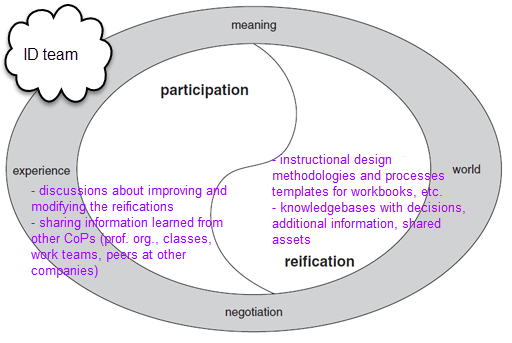Meaning
These notes are part of a series for the book.
Note: I reference this chapter in my essay, The duality of participation and reification, and a little Bolero.
Outline
- Negotiation of meaning
- The dynamics of negotiated meaning
- Participation
- Reification
- The concept of reification
- The double edge of reification
- The duality of meaning
- The complementarity of participation and reification
- A fundamental duality; participation and reification:
- Are a duality, not opposites
- Are two dimensions that interact; they do not define a spectrum
- Imply each other; they do not substitute for each other
- Transform their relation; they do not translate into each other
- Describe an interplay; they are not classificatory categories
Notes
‘Learning is first and foremost the ability to negotiate new meanings’ (from the 13 principles defining learning, Wenger, 1998, p. 226).
Social production of meaning in practices: The meanings are what’s important in our activities, not the activities themselves. ‘Practice is about meaning as an experience of everyday life’ (Wenger, 1998, p. 52). Meaning is negotiated in an interaction between participation and reification.
Meaning is negotiated
Wenger uses the word “negotiated” in 2 ways:
- Reaching an agreement (like, negotiating a price)
- Accomplished with attention and readjustment (like, negotiating a sharp curve)
Negotiation involves participation and reification
Participation is renegotiating meaning. Reification is creating the conditions for new meanings.
Participation: Between members of social communities, with actors who have the possibility of mutual recognition; participation shapes the community. To participate is to act and to connect.
- Unlike a systems view of the social world, Wenger only includes members of communities as actors who participate. That is, for example, he excludes the computer even if it plays a part in the actions of a community. His definition of the actors requires that they have ‘mutual recognition’ (Wenger, 1998, p. 56).
- Mutual recognition means being able to see something of yourself i another. Because participation involves actors who mutually recognize each other, participation is a ‘source of identity’ (Wenger, 1998, p. 56).
- Social participation is about participating in a social world. So, it can include activities that do not involve being with other people. ‘Even drastic isolation — as in solitary confinement, monastic seclusion, or writing — is given meaning through social participation’ (Wenger, 1998, p. 57).
Reification: The creation of artifacts that document participation and give shortcuts for communication; this is a process and a product. Examples of artifacts created by reification:
- Smoke signal
- Clock
- Form
- Logo
- Statue
- Painting
- Meeting notes
- Recipes
- Medical procedures
- Lesson plans
- Address lists
- Concepts and theories
One problem with reification is that it is so succinct — this is generally good, but sometimes people forget or forgo learning the meaning behind it. For example, this happens when:
- People learn procedure but not concepts
- A slogan replaces deeper meaning
Participation and reification are dualities
Participation and reification are:
- Always together
- Dimensions that interact
- Not opposing
- Not ends of a spectrum
The duality of participation and reification (Wenger, 1998, p. 63)
This is how I think the duality works within instructional design (ID) and software development teams:


| Characteristic | Participation | Reification |
|---|---|---|
| Each helps the other | Helps reification: ambassadors sent with treaties; meetings introduce policies to help clarify them; customer service call centers go with documentation; judges interpret laws. | Helps participation: notes remind us of decisions made; meeting times are coordinated with clocks; monuments remind us of the dead. |
| They have to be in balance; if you increase one, you usually have to increase both | If there is too much, nothing documents what was agreed and learned. | If there is too much, there isn't be enough participation to generate meaning. |
| Help with remembering and forgetting | Provides us with memories which we interpret as part of our identity and it too is malleable as our perspectives change over time. | Allows for multiple interprestations and reinterpretations over time. |
See also
Rogoff, B. (2003) ‘Thinking with the Tools and Institutions of Culture’
